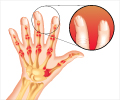Apremilast Medication Information
Learn everything you need to know about Apremilast-pronunciation, uses, dosage guidelines, indications, and when to take or avoid it.
Get up-to-date information on side effects, precautions, warnings, and proper storage to ensure safe usage.
Explore Apremilast brand names commonly used in India and internationally, along with detailed pricing information. Consult your healthcare provider for tailored medical advice.
Generic Name : Apremilast Pronunciation : a-PREM-i-lastBrand Names or Trade Names of Apremilast
India :
Otezla
Overview of Apremilast
Apremilast is an inhibitor of the enzyme phosphodiesterase 4 (PDE4) indicated for the treatment of adult patients with joint pain due to arthritis.Why is Apremilast Prescribed? (Indications)
Apremilast acts by inhibiting the enzyme named phosphodiesterase 4 (PDE4).When should Apremilast not be taken? (Contraindications)
Apremilast should not be used in patients•If there is an allergy to apremilast
•Below 18 years
What is the dosage of Apremilast?
Apremilast is available in the form of tablets of doses 10 mg, 20 mg or 30 mg to be taken daily by mouth for joint pain due to psoriasis.The dose should be increased gradually to avoid gastric irritation and acidity.
How should Apremilast be taken?
Apremilast tablets should be given according to this given schedule:Day 1: one 10 mg tablet in the morning
Day 2: one 10 mg tablet in the morning and one 10 mg tablet in the evening
Day 3: one 10 mg tablet in the morning and one 20 mg tablet in the evening
Day 4: one 20 mg tablet in the morning and one 20 mg tablet in the evening
Day 5: one 20 mg tablet in the morning and one 30 mg tablet in the evening
Day 6 and thereafter: 30 mg 2 tablets daily
What are the warnings and precautions for Apremilast?
•Patients are advised to be alert for the emergence of symptoms of depression, suicidal thoughts or any other mood changes and if such changes occur to contact with their doctor•Carefully weigh the risks and benefits of apremilast in patients with a history of depression and/or suicidal thoughts.
•Weight should be monitored regularly as apremilast can decrease weight. If significant weight loss occurs, evaluate weight loss and consider discontinuation of apremilast
What are the side effects of Apremilast?
Gastrointestinal: Nausea, vomiting, diarrhea, upper abdominal pain, dyspepsia, decreased appetiteNervous system: Headache
Respiratory: Inflammation of Nose and pharynx, upper respiratory tract infection
Skin: Rash, allergies
Lab abnormalities: Weight should be monitored regularly
What are the other precautions for Apremilast?
• Caution should be exercised when using apremilast in a nursing woman.• The recommended dose is one tablet 30 mg daily in case of severe kidney damage.
• In case of overdose with apremilast, patients should seek immediate medical help.
• Symptomatic and supportive care should be taken in this case.







